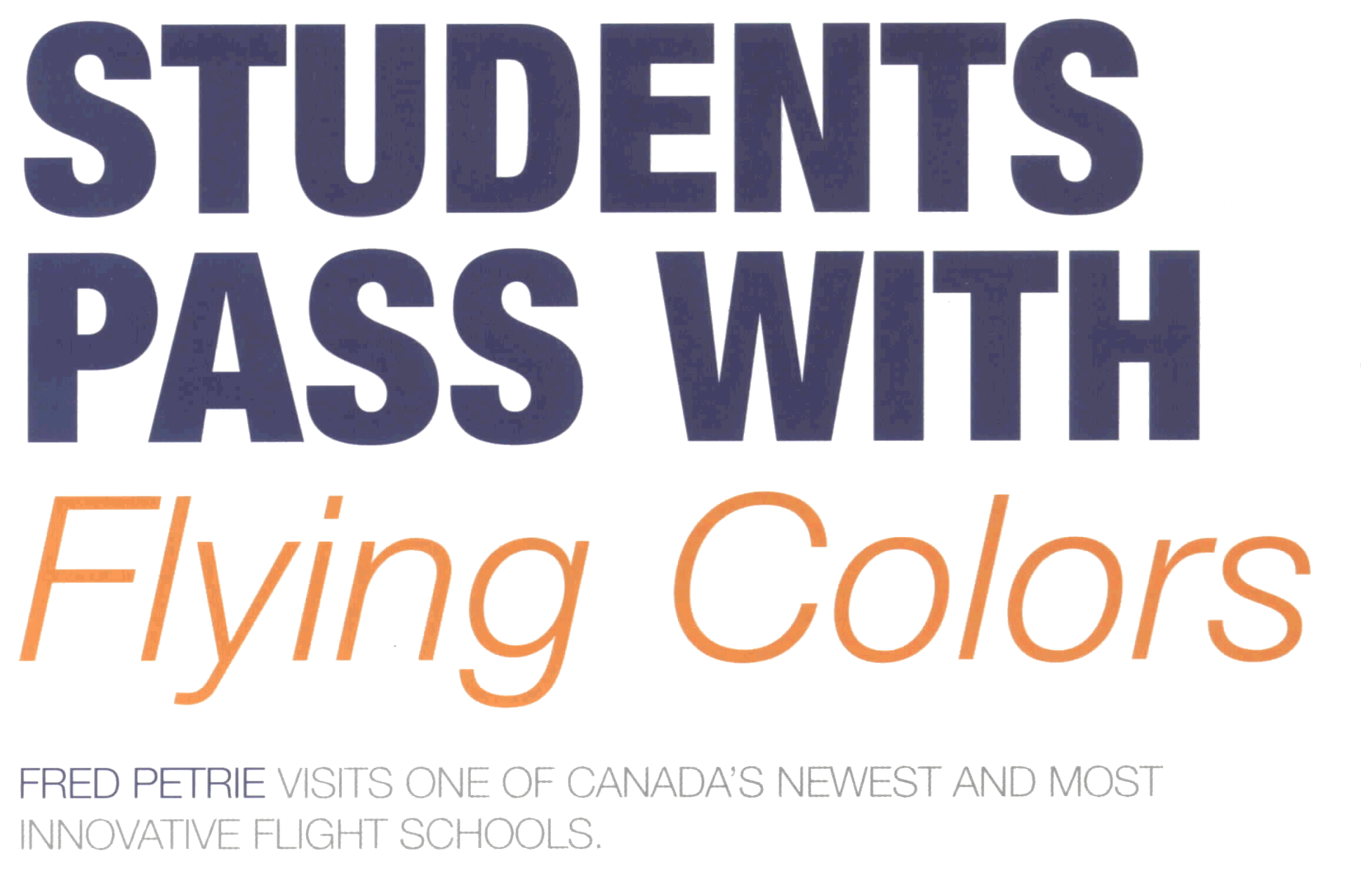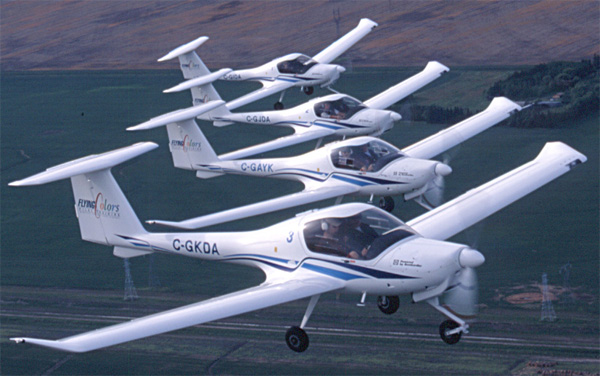
 |
Flying Colors operates Canada's first
Transport Canada certified Level
3 Flight Training Device and offers the region's only baccalaureate
aviation degree program. It was enough to impress the Air Transport
Association of Canada (ATAC),
which awarded Flying Colors its prestigious Innovation
Award after only its second year of operation.
For Gillespie, who grew up around airplanes,
it was recognition for a path he almost did not take. Formerly trained
in computer science and new products management at the University of Manitoba,
Gillespie was more interested in broadcast engineering and the manufacture
of specialty electronics. It was not until he watched his brother win the
1991 Canadian Aerobatics Championship that he experienced what he describes
as "the brotherhood of aviation". He obtained his private pilots
license
in 1996. As an entrepreneur, Gillespie began considering full-time aviation
activities. The Flying
Colors Precision Flight Team was the result. The idea was inspired
by the EAA
Young Eagles program to introduce youth to aviation.
While developing the business plan,
two factors converged. First, the team would require a Transport Canada
Operating Certificate; second, he had not been impressed by the flight
training offerings in the mid-90s when he had decided to pursue his own
licence (in fact, he bought his own aircraft and hired a private instructor).
Thus came the foundation for Gillespie's three pillars.
TECHNOLOGY
Gillespie's first decision was to employ
the latest technology in his new flight school. This led to choosing the
new Diamond
DA20 Katana aircraft. The panels and avionics are equally part of technology.
Three are equipped for VFR
flight while one IFR trainer uses 'steam
gauges' (i.e., analog); two offer Garmin
cockpits and two are EFIS-equipped,
unusual in ab initio flight training. In addition to its aircraft fleet,
Flying Colors offers the latest in Flight Training Devices, a Vector
Systems 'Vision I'. It is certified by Transport Canada as a Level
III FTD which means that time in the FTD counts the same as hours in an
aircraft. I had to challenge Gillespie on the competitiveness of all this
latest technology, compared to older Cessna and Piper trainers used by
other schools. He granted that the hourly rate might be slightly higher
on the new Katanas, but that the overall program costs for students are
competitive, if not more economical. He cited two reasons: Use of the lower
cost FTD for up to 30 hours (with more effective learning of procedures)
and the instrumentation for IFR training that minimizes cost for most students
in the multi-IFR phase. As a further innovation, Gillespie had the FTD
installed in a van so it could be taken out to schools and career days.
The Flying Colors program also incorporates the latest in computer, Internet
and communications technology. Students use personal laptops and the Internet
for the distance education degree and diploma programs. Every student receives
an e-mail account and all bookings are made on-line. The Flying Colors Web site (www.flying-colors.org)
has proven very popular with its aviation
weather page being 'hit' an average of every 10 seconds.
PARTNERSHIPS
Rather than doing it all alone, Flying
Colors' success is based on several key partnerships that Gillespie has
cultivated from the beginning. Initially using classrooms at nearby Sturgeon
Creek Collegiate for ground schools, Gillespie worked closely with
the principal for continuing education of the St.
James School Division, Brian Head, in developing programs. This partnership
culminated in the September
2002 introduction of the first high school vocational program in aviation.
While based on commercial pilot ground school requirements, the
eight-credit, 880-hour program will provide a good grounding for all
aviation careers, whether in airports, maintenance, airline operations
or air navigation services. And students who decide to pursue a flying
career will have a strong academic basis to work from, including hours
in the FTD and the option to pursue pilot training on their own while completing
high school. Gillespie commented on the oft-quoted statistic that 80% of
those who start pilot training do not complete it, and that 80% of those
who do get a licence are no longer active after five years. The greatest
value of the high school program may be to select out many of the 80%;
the results will be closely watched to see if this new program does in
fact improve the success ratio. The Manitoba
Aviation Council is also watching this program with keen interest.
Assuming the two-year trial proves successful, the plan is to extend the
program to other school divisions and flight schools around the province.
Flying Colors enjoys a strong relationship
with the Canadian Forces, being located adjacent to the Canadian
Air Division Headquarters. Maj Ken Glass of the Aeromedical
Training Centre has provided opportunities to use the CF's hyperbaric
chamber - how many ab initio students get to experience hypoxia at 30,000
feet? LCol Michel (Mike) Latouche, the new CO of the 435 Herc Squadron in Winnipeg, and a navigator himself, teaches the
navigation ground school. Latouche has also taken up piloting and is now
a part-time flight instructor. The CF provides reimbursement of continuing
education and a number of military personnel are undertaking flight training
at Flying Colors.
Flying Colors' professional flight
students take their multi-engine and IFR endorsements with Perimeter
Aviation, also located at Winnipeg International Airport. "Why
reinvent
the wheel," says Gillespie, "when one of the best specialist flight
trainers
in the country is right here?" Perimeter Aviation has been offering
advanced
flight training since 1960 in its fleet of specially-equipped Beech
Travelairs (equipped for known icing) and its FTDs including a
Jeppeson
FS200 and PFC Elite simulators. Perimeter
Airlines is also an employer of Flying Colors graduates.
Utah
Valley State College is Flying Colors' primary academic partner. UVSC
was the first institution to offer its aviation
diploma and degree programs entirely on-line for distance education.
Flying Colors, the only Canadian school partner, has also worked with UVSC
to provide accreditation for Canadian academic components. Flying Colors
recently partnered with Everglades
College, a private institution, which will be able to offer a masters
program.
[Editor Note: Subsequent
to
this
article, Flying Colors announced
Canada's newest
Integrated Aviation and Baccalaureate Program in collaberation with Canadian
Mennonite University, located in Winnipeg.]
CUSTOMER SERVICE
Gillespie's focus on customer service
goes back to his own experience looking for flight training, where he had
been disappointed in the fleets offered and their location, not to mention
some attitudes. The first tenet of customer service is to be where the
customer wants to be. CYWG
provides the central and most convenient
location for the most students; it also provides the environment in
which students will be operating for much of their careers. Gillespie reports
that he has received excellent cooperation from Nav Canada and Transport
Canada, and with the resolution of allowing flight training at YWG - contrary
to Transport Canada's old policy when it ran the airport, there is good
operations support from the Winnipeg
Airports Authority.
Flying Colors understands that students
are preparing for a career, not just earning a licence. This means providing
the extra skills required for working in the industry; Gillespie also works
with air carriers to provide internship opportunities.
The most unique aspect of Flying Colors'
program is its 'inverted/accelerated' approach. Most college and
university
flight programs phase flight training throughout the academic program.
Flying Colors provides the opportunity to complete the flight licence and
ratings in as little as 10 months. The students then continue to complete
the academic requirements of their diploma or degree program over a further
one to three years (diploma and degree respectively). Putting all the flight
training first is 'inverted' com-pared to other programs. The 'accelerated'
refers to the students going to work while they complete their academic
studies. As another example of practising what they preach, five of Flying
Colors' dozen flight instructors are also students in the academic program.
The result is that four years after their 'discovery' flight, a 'customer'
student not only has all the licences and a degree, but can also have 1,000
to 2,000 flight hours and be well established on a rewarding career path.
"A professional flight student may spend up to $50,000 getting all the
licences and enough experience to get a job," said Gillespie, "but
with
our program, they have the opportunity to earn that $50,000 back by the
time they would have got the licences and degree in a traditional
program."
THE FUTURE
From growing up with video games, including
'Flight Simulator',
today's students are natural instrument flyers. Employers
are more demanding, most airlines expect a degree, and this will see more
flight training units aligning with educational institutions, even as the
number of units declines with industry consolidation into larger schools.
Flying Colors' approach to these challenges is to explore new means of
delivering programs, such as the high school program, to become even more
interactive and participatory. Flying Colors feels strongly about involvement
in the community and makes a point of attending aviation events around
Manitoba and sponsoring GA workshops.
Financial support for flight training
remains a major challenge for many aspiring to an aviation career. If new
programs are developed, they may be tied to more stringent qualification
requirements, perhaps like military selection processes. Meeting the cost
pressures of aircraft, fuel, insurance and a myriad of fees will demand
all of the industry's ingenuity.
Nevertheless, the demographics of the
population as a whole, and the compulsory retirement age for airline pilots,
is going to keep the demand for pilots strong. Growth in the economy and
greater demand for personal aviation, the pilots for the new Eclipse jets, will also drive the demand for pilot
training.
Young people looking to join the brotherhood
(and sisterhood) of aviation will have the opportunity.
© 2002 Annex
Publishing and Printing Inc.
Email the author: Fred Petrie fpetrie@shaw.ca
For information, please contact:
admin@flying-colors.org
 What makes a brand new flight school an industry leader in just a few
short years?
For Michael Gillespie, president and founder of Winnipeg-based Flying
Colors Pilot Training, it is a business plan built on three pillars:
technology, partnerships and customer service.
What makes a brand new flight school an industry leader in just a few
short years?
For Michael Gillespie, president and founder of Winnipeg-based Flying
Colors Pilot Training, it is a business plan built on three pillars:
technology, partnerships and customer service.
Photographs Courtesy of
and © 2002 Flying Colors Pilot
Training
Reprinted with Permission